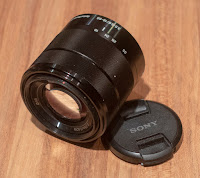OK, not the last lens review, but the last lens I will review on the Sony A6000. Yeah, baby! I'm going full frame! Found a great deal on a used Sony A7ii, so jumped on it. It will be nice to use lenses in the format they were actually designed for.
So, what better to end then the standard kit lens for the Sony a6000... and strangely enough, I did not by it together with my body, but only a month ago, also as good deal I could not pass by. This is the first lens I used that was actually made for the APS-C format, and the first one using in-lens-stabilisation and native fast auto-focus.
The lens looks a little cheap, due to the glossy black plastic, but is elegant in it's own right.
As with most recent auto-focus lenses, it does not come with an aperture ring, so aperture can only be set via the camera. So pretty useless in manual use.
The focus can be manual and auto, but be aware that in manual, the focus ring is not direct but is driving a step motor, so has a very small delay. Focus and zoom are very smooth and easy to handle.
The lens also comes with a good butterfly hood. And auto-focus is super fast on the Sony A6000. You will not miss a shot!
The lens produces nice colors, but is maybe not as sharp as it should. It's not bad, but I have older lenses that are sharper. But hey, it's kit lens, so no miracles. It's also not a fast lens, but with the build in stabilisation (OSS - Optical Steady shot), that is not much of an issue, unless shooting in darker situations.
I understand that the image quality is not the highest standard (distortion, color fringes,...) but this is compensated by the in-camera lens correction. And it's the end quality that counts.
To be fair, this was not my first copy of this lens. I also owned a silver version that I managed to destroy when cleaning the inside, to remove a pine-needle (no idea how it got in there in the first place). One of the connectors broke off... so be warned, if you need to open the lens, it get's pretty fragile. Lesson learned.
In conclusion, it's not a bad lens, and perfect for a beginning photographer. But I do believe that after a while, you will start yearning after something a tad sharper.
Focal Length: 18-55mm (27-82.5 35mm equivalent)
Maximum Aperture: F3.5-5.6
Minimum Aperture: F22-32
Image Format: APS-C
Lens Mount: E-Mount
Optics: 9 groups- 11elements
Blades: 7
Focussing: Auto
Image Stabilisation: Optical Steady Shot (OSS)
Minimum Focus: 25cm
Filter Size: 49mm
Weight: 194g
Length: 62mm
Production: 2010 to current
Serial Number: 8235252
Made in: Thailand
 |
| 1/160s - f/5.6 - 55mm - ISO2000 - Handheld |
 |
| 1/60s - f/4.6 - 34mm - ISO100 - Handheld |
 |
| 1/60s - f/4 - 18mm - ISO250 - Handheld |
 |
| 1/400s - f/4 - 29mm - ISO100 - Handheld |
 |
| 1/500s - f/4.5 - 39mm - ISO100 - Handheld |
 |
| 1/640s - f/5.6 - 54mm - ISO100 - Handheld |
 |
| 1/100s - f/5 - 33mm - ISO100 - Handheld |
 |
| 1/800s - f/5 - 52mm - ISO100 - Handheld |
 |
| 1/160s - f/4 - 30mm - ISO160 - Handheld |
 |
| 1/160s - f/5 - 52mm - ISO160 - Handheld |
 |
| 1/200s - f/5.6 - 22mm - ISO100 - Handheld |
flickr.com
kurtmunger.com
Ken Rockwell
































































